Tang Yuan, or sweet rice balls, are a beloved Chinese dessert often enjoyed during festivals. These delightful treats are made from glutinous rice flour and typically filled with sweet or savory fillings. Tang Yuan symbolizes unity and togetherness, making them a perfect dish for family gatherings. This article will guide you through making Tang Yuan with a delicious peanut filling, ensuring you can create this traditional delicacy at home. Dive in to discover the ingredients, preparation steps, and serving tips for perfect Tang Yuan every time.
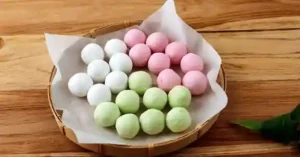
Introduction to Tang Yuan
What are Tang Yuan?
Tang Yuan are traditional Chinese glutinous rice balls that are enjoyed for their unique texture and sweet taste. The term “Tang Yuan” refers to the round shape of the rice balls, which symbolizes unity and completeness. The dough is made from glutinous rice flour mixed with water to create a soft, chewy consistency. Tang Yuan can be served in a sweet broth, such as ginger syrup, or with savory fillings depending on regional preferences and festive occasions.
Meaning and Symbolism of Tang Yuan
Tang Yuan holds a special place in Chinese culture, particularly during the Lantern Festival and the Winter Solstice Festival. The round shape of the rice balls signifies family unity and togetherness. It is believed that eating Tang Yuan during these festivals brings good fortune and harmony to the family. The dish’s symbolic value makes it a cherished part of traditional celebrations and an important culinary heritage in Chinese cuisine.

Preparing the Peanut Filling
How to Prepare Oozy Peanut Filling
To create a delicious and oozy peanut filling for Tang Yuan, you’ll need to start with high-quality peanuts. Here’s how you can prepare it:
Ingredients:
- 1 cup roasted peanuts (unsalted)
- 1/4 cup powdered sugar
- 2 tablespoons vegetable oil or melted butter
- Optional: 1-2 tablespoons honey or condensed milk for added sweetness
Steps:
- Grind the Peanuts: Use a food processor to grind the roasted peanuts into a fine powder. This ensures that the filling will have a smooth, creamy texture.
- Mix Ingredients: In a mixing bowl, combine the ground peanuts with powdered sugar. Add vegetable oil or melted butter to bind the mixture. If desired, add honey or condensed milk for extra sweetness.
- Form the Filling: Once the mixture is well combined and slightly sticky, shape it into small balls or spoonfuls. This makes it easier to place inside the Tang Yuan dough.
Tips to Ensure the Filling Doesn’t Leak Out
Proper wrapping is crucial to prevent the filling from leaking out during cooking. Follow these tips:
- Seal the Edges Well: When wrapping the filling in the dough, make sure the edges are pinched and sealed tightly. This prevents the filling from escaping while boiling.
- Use Slightly Damp Hands: Lightly wetting your hands can help in handling the dough and forming smooth, well-sealed balls.
- Avoid Overstuffing: Be cautious not to overfill the dough. Leave enough dough around the filling to ensure a good seal and prevent bursting during cooking.
Make-Ahead Instructions
Preparing the peanut filling in advance can save time and ensure a smoother cooking process:
- Storage: Store the peanut filling in an airtight container in the refrigerator for up to a week. If making further in advance, you can freeze the filling for up to a month. Just be sure to thaw it in the refrigerator before use.
- Preparation Time: Prepare the filling at least a few hours before making Tang Yuan to allow the flavors to meld and the texture to firm up.
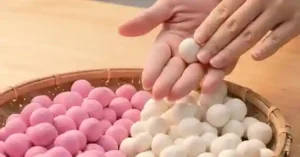
Ingredients Overview
Ingredients for Dough
The dough for Tang Yuan is made from glutinous rice flour, which provides the signature chewy texture. Here’s what you’ll need:
Glutinous Rice Flour:
2 cups. This special flour is essential for the dough’s texture. It’s different from regular rice flour and is often labeled as “sweet rice flour” or “mochi flour” in stores.
Water:
1 cup. Adjust the amount slightly if needed to achieve the right dough consistency.
Optional Ingredients:
Food Coloring:
A few drops if you want to make colorful dough. Use natural colorants like beet juice for red or matcha powder for green.
Ingredients for Peanut Filling
The peanut filling is the heart of the Tang Yuan, providing a rich, nutty flavor. The key ingredients are:
Roasted Peanuts:
1 cup. These should be unsalted and can be found in most grocery stores. They are ground to create a smooth or slightly chunky filling.
Powdered Sugar:
1/4 cup. This helps to sweeten the filling and balance the flavor.
Vegetable Oil or Melted Butter:
2 tablespoons. This binds the filling and gives it a smooth, creamy texture.
Optional Additions:
Honey or Condensed Milk:
1-2 tablespoons if you prefer a sweeter filling.
Ingredients for Sweet Ginger Syrup
The sweet ginger syrup complements the Tang Yuan, adding a warming, aromatic flavor:
- Fresh Ginger: 2-3 slices. Adds a spicy, aromatic note to the syrup.
- Rock Sugar or Brown Sugar: 1/2 cup. Provides sweetness and a subtle caramel flavor.
- Water: 3 cups. Used to dissolve the sugar and extract the ginger flavor.
Ingredient Tips:
- Glutinous Rice Flour: Ensure you use glutinous rice flour, not regular rice flour or other substitutes. This flour creates the desired chewy texture in Tang Yuan.
- Roasted Peanuts: For the best flavor, use unsalted roasted peanuts. If you roast your own, be sure to let them cool completely before grinding.
- Sweeteners: Adjust the amount of sugar or sweeteners according to your taste preferences. The sweetness should complement the peanut filling without overpowering it.

Making the Dough
Steps to Prepare Tang Yuan Dough
Creating the perfect Tang Yuan dough involves a simple yet crucial process. Here’s how you can make it:
Ingredients:
- 2 cups glutinous rice flour
- 1 cup water (adjust as needed)
- Optional: Food coloring (if desired)
Preparation Steps:
Combine Ingredients:
In a large mixing bowl, combine the glutinous rice flour and water. Mix well until a smooth, lump-free dough forms. If you are using food coloring, add it to the water before mixing to ensure even color distribution.
Adjust Consistency:
If the dough is too dry and crumbly, add a little more water, a tablespoon at a time, until it reaches a smooth, pliable consistency. Conversely, if the dough is too sticky, add a small amount of glutinous rice flour.
Knead the Dough:
Once the dough comes together, knead it for a few minutes to make it soft and elastic. This step is crucial for achieving the right texture in the finished rice balls.
Rest the Dough:
Cover the dough with a damp cloth or plastic wrap and let it rest for about 30 minutes. This resting period allows the flour to fully absorb the water, making the dough easier to work with.
Coloring the Dough (Optional):
Add Color:
If you want to make colorful Tang Yuan, divide the dough into portions and add a few drops of food coloring to each portion. Knead each portion until the color is evenly distributed.
Natural Colorants:
For natural coloring, you can use ingredients like beet juice for red, matcha powder for green, or turmeric for yellow. Mix these into the dough just as you would with food coloring.
Tips for Perfect Dough:
- Consistency is Key: The dough should be soft and slightly tacky but not sticky. It should be easy to mold into balls without cracking.
- Avoid Overworking: Over-kneading can make the dough too tough. Knead just until smooth and elastic.
- Resting: Don’t skip the resting step. It helps the dough to be more pliable and easier to shape.
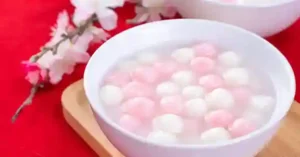
Shaping and Filling the Dough
How to Wrap Tang Yuan with Filling
Properly wrapping Tang Yuan ensures that the filling stays enclosed and the rice balls maintain their shape during cooking. Follow these steps to achieve well-sealed Tang Yuan:
Prepare the Work Surface:
Lightly dust your work surface and hands with glutinous rice flour to prevent sticking. This also helps in handling the dough smoothly.
Portion the Dough:
Divide the dough into small, even portions. Each portion should be about 1-2 tablespoons in size, depending on how large you want your Tang Yuan to be.
Flatten the Dough:
Take one portion of dough and gently flatten it into a small disc with your fingers or the palm of your hand. Aim for a thickness of about 1/8 inch (3 mm) to ensure even wrapping.
Add the Filling:
Place a small ball of peanut filling in the center of the flattened dough disc. Avoid overfilling, as this can make sealing difficult.
Wrap the Filling:
Gently fold the edges of the dough over the filling, pinching and sealing them together at the top. Ensure that there are no gaps or holes where the filling might escape.
Shape the Rice Balls:
Roll the filled dough between your palms to form a smooth, round ball. Make sure the surface is even and the seams are sealed properly.
Ensuring Proper Sealing
Pinch the Edges:
When sealing the dough around the filling, pinch the edges together firmly. This helps to create a tight seal and prevents the filling from leaking out during cooking.
Smooth the Surface:
After sealing, smooth out any creases or uneven areas on the surface of the rice ball. This helps in cooking evenly and avoiding splits.
Check for Leaks:
Before cooking, gently press the rice ball to ensure it is sealed well. If any filling is visible or if you find any weak spots, reshape and pinch the dough to close them.
Tips for Shaping Tang Yuan
Use Moist Hands:
If the dough starts sticking to your hands, lightly moisten them with water to make handling easier.
Consistent Size:
Try to keep the size of each Tang Yuan consistent to ensure even cooking. Using a cookie scoop can help in measuring uniform portions.
Avoid Overstuffing:
Overstuffing can cause the dough to break open while cooking. A small amount of filling is usually sufficient and allows for easier sealing.
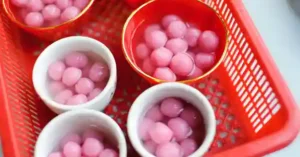
Cooking Tang Yuan
Boiling the Glutinous Rice Balls
Cooking Tang Yuan involves a simple boiling process that ensures the rice balls are cooked through and achieve their signature chewy texture. Here’s how to do it:
Prepare the Water:
Fill a large pot with enough water to fully submerge the Tang Yuan. For best results, use about 4-5 cups of water for every dozen rice balls.
Bring to a Boil:
Heat the water over medium-high heat until it comes to a rolling boil.
Add the Tang Yuan:
Gently drop the shaped Tang Yuan into the boiling water. To avoid sticking, add them in batches if necessary, ensuring they have enough space to move around.
Cook Until Floating:
Let the Tang Yuan cook for about 5-7 minutes. They are ready when they float to the surface and have a slightly translucent appearance. Stir gently occasionally to prevent them from sticking to the bottom of the pot.
Test for Doneness:
To ensure they are fully cooked, you can take one out and cut it in half. The dough should be smooth and the filling should be hot.
Remove and Drain:
Use a slotted spoon to remove the Tang Yuan from the boiling water. Place them in a bowl of cold water for a few seconds to stop the cooking process and prevent sticking.
Cooking Time and Tips
Avoid Overcrowding:
Do not overcrowd the pot. Adding too many Tang Yuan at once can lower the water temperature and cause uneven cooking. Cook in batches if needed.
Stir Gently:
Stir the Tang Yuan gently to prevent them from sticking to each other or to the pot. A wooden spoon or a heat-resistant spatula works well for this.
Maintain Boil:
Ensure the water remains at a rolling boil throughout the cooking process. If the water level drops too low, add a little more boiling water.
Test and Adjust:
If the Tang Yuan are not floating after 7 minutes, give them a few more minutes to cook through. The texture should be soft and chewy, with a slightly translucent appearance.
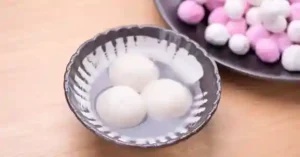
Preparing the Sweet Ginger Syrup
Ingredients and Preparation Steps
The sweet ginger syrup adds a delightful, aromatic touch to Tang Yuan. Here’s how to prepare it:
Ingredients:
- 2-3 slices fresh ginger
- 1/2 cup rock sugar or brown sugar
- 3 cups water
Preparation Steps:
Prepare the Ginger:
Peel the ginger and slice it into thin pieces. The thin slices help release more flavor into the syrup.
Combine Ingredients:
In a medium-sized saucepan, combine the sliced ginger, sugar, and water.
Cook the Syrup:
Heat the mixture over medium heat until it reaches a gentle simmer. Stir occasionally to help dissolve the sugar completely.
Simmer:
Once the syrup starts to simmer, reduce the heat to low. Allow it to simmer for about 10-15 minutes. This helps infuse the ginger flavor into the syrup and creates a slightly thicker consistency.
Taste and Adjust:
Taste the syrup to check the sweetness and ginger flavor. If needed, adjust the sweetness by adding a little more sugar. Simmer for an additional 5 minutes if you add more sugar to ensure it dissolves properly.
Strain the Syrup:
Once the syrup has reached your desired flavor, strain out the ginger slices using a fine mesh strainer. This leaves you with a smooth, clear syrup.
Cool and Store:
Allow the syrup to cool to room temperature. You can use it immediately or store it in an airtight container in the refrigerator for up to a week.
Tips for Perfect Syrup:
Adjust Sweetness:
Rock sugar gives a more subtle sweetness and richer flavor, but brown sugar works well if you prefer a deeper, caramel-like taste. Adjust according to your preference.
Ginger Intensity:
For a milder ginger flavor, use fewer slices or cook for a shorter time. For a stronger flavor, add more ginger slices or simmer longer.
Consistency Check:
The syrup should be slightly thickened but still liquid. If you find it too thin, simmer it for a bit longer to reduce and thicken.
Serving Temperature:
The syrup can be served warm or at room temperature with Tang Yuan. If reheating, do so gently to avoid burning the syrup.
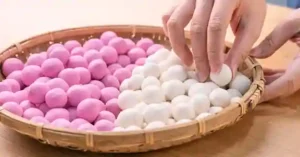
Serving Tang Yuan
How to Serve Tang Yuan
Serving Tang Yuan properly enhances the overall dining experience. Here’s how you can serve these sweet rice balls to make them look and taste their best:
Prepare the Serving Dish:
Choose a bowl or dish that can hold the Tang Yuan and syrup comfortably. Traditional options include small porcelain bowls or clear glass dishes that showcase the rice balls and syrup.
Warm the Syrup:
If the sweet ginger syrup has been refrigerated, gently reheat it until it’s warm but not boiling. The syrup should be served warm or at room temperature to complement the Tang Yuan.
Place the Tang Yuan:
Gently ladle the cooked Tang Yuan into the serving bowl. Ensure they are placed in a single layer or with a bit of space between them to avoid sticking.
Add the Syrup:
Pour the warm sweet ginger syrup over the Tang Yuan. Make sure each rice ball is covered with the syrup. The syrup adds flavor and moisture to the rice balls, enhancing their taste.
Garnish (Optional):
For an extra touch, you can garnish with additional ingredients such as:
- Chopped Nuts: Add a sprinkle of chopped peanuts or sesame seeds for added texture.
- Fresh Herbs: A few sprigs of mint or a sprinkle of dried chrysanthemum petals can add a fresh aroma.
Serving Suggestions:
- As a Dessert: Tang Yuan is traditionally served as a dessert, especially during festive occasions. Enjoy it as a sweet end to a meal or as part of a larger celebration.
- With Tea: Pairing Tang Yuan with a mild tea, such as jasmine or oolong, can complement the sweetness and enhance the overall dining experience.
Presentation Tips:
Showcase the Color:
If you’ve made colorful Tang Yuan, use a clear or white dish to highlight the vibrant hues of the rice balls and syrup.
Keep the Syrup Warm:
If serving at a large gathering, consider keeping the syrup warm in a slow cooker or on a hot plate to maintain the best texture and temperature.
Portion Size:
Serve Tang Yuan in small portions as it is a rich and sweet dessert. A few rice balls per serving is usually sufficient.

Tang Yuan Sweet Chinese Peanut Rice Balls Variations and Customizations
Different Flavors and Fillings
Tang Yuan can be adapted with various flavors and fillings to suit different tastes and occasions. Here are some popular variations:
Sweet Red Bean Filling:
Ingredients:
- 1 cup cooked adzuki beans
- 1/2 cup sugar
- 1-2 tablespoons water (as needed)
Preparation:
- Cook Beans: Cook adzuki beans until soft. Drain and mash them.
- Sweeten: Combine the mashed beans with sugar in a saucepan. Cook over low heat, adding water as necessary until the mixture is thick and smooth.
- Cool: Let the filling cool before using it in Tang Yuan.
Black Sesame Filling:
Ingredients:
- 1 cup black sesame seeds
- 1/2 cup powdered sugar
- 2 tablespoons melted butter
Preparation:
- Grind Seeds: Toast black sesame seeds and grind them into a fine powder.
- Mix: Combine the ground seeds with powdered sugar and melted butter. Mix until smooth.
- Cool: Let the mixture cool before using it as a filling.
Savory Tang Yuan:
Ingredients:
- 1 cup minced pork or mushrooms
- 2 tablespoons soy sauce
- 1 tablespoon sesame oil
- 1 teaspoon sugar
Preparation:
- Cook Filling: Sauté the minced meat or mushrooms with soy sauce, sesame oil, and sugar until fully cooked.
- Cool: Allow the mixture to cool before using it as a filling for savory Tang Yuan.
Customizations:
Flavored Dough:
- Matcha Dough: Add 1-2 teaspoons of matcha powder to the dough to give it a green color and a subtle, earthy flavor.
- Cocoa Dough: Mix in 1-2 tablespoons of cocoa powder for a chocolatey twist.
Colorful Dough:
- Natural Dyes: Use beet juice for pink, spinach powder for green, or turmeric for yellow. Add these to the water before mixing with glutinous rice flour.
Additional Garnishes:
- Coconut Flakes: Sprinkle toasted coconut flakes on top for a tropical flavor.
- Chopped Nuts: Add crushed peanuts or walnuts for extra crunch.
- Herbs and Spices: Incorporate spices like cinnamon or cloves into the filling for added depth of flavor.
Serving Variations:
Cold Tang Yuan:
Serve Tang Yuan chilled for a refreshing twist, especially during hot weather. Refrigerate the cooked rice balls and syrup, then serve cold.
Tang Yuan in Soup:
Add Tang Yuan to a light broth or soup for a savory version. The sweet rice balls pair well with clear or mildly flavored soups.
Expert Tips and Notes
Storage and Reheating
Storage:
Uncooked Tang Yuan:
Store uncooked Tang Yuan in an airtight container in the refrigerator for up to 24 hours. If you need to store them longer, freeze them. Place the uncooked rice balls on a baking sheet and freeze until solid, then transfer to a freezer bag or container. They can be stored in the freezer for up to a month.
Cooked Tang Yuan:
Cooked Tang Yuan can be stored in the refrigerator for up to 3-4 days. Place them in an airtight container with the sweet ginger syrup or separately to prevent them from becoming mushy.
Reheating:
Reheating in Water:
To reheat Tang Yuan, bring a pot of water to a boil and gently add the rice balls. Boil for 2-3 minutes or until heated through. If reheating Tang Yuan with syrup, heat the syrup separately and then add the rice balls to warm them together.
Microwave:
If you prefer, you can use the microwave. Place Tang Yuan in a microwave-safe bowl, cover with a damp paper towel, and heat in short intervals until warm. Be careful not to overheat, as this can affect the texture.
Troubleshooting Common Issues
Dough Cracking:
- Cause: Cracking usually occurs if the dough is too dry or if the filling is overstuffed.
- Solution: Ensure the dough is soft and pliable by adjusting the water content. If you experience cracking, try adding a small amount of water to the dough and knead it again.
Filling Leaks:
- Cause: Leaking filling can result from improper sealing or overfilling.
- Solution: Ensure the edges of the dough are sealed tightly. Avoid overstuffing the dough, and gently shape the rice balls to prevent any weak spots.
Tang Yuan Sticking Together:
- Cause: Tang Yuan can stick together if not handled properly or if the water temperature is not high enough.
- Solution: Lightly coat the Tang Yuan with glutinous rice flour before cooking. Ensure the water is boiling before adding the rice balls and stir gently to prevent sticking.
Additional Recipe Ideas
Tang Yuan with Fruit Fillings:
Mango or Red Bean:
Use fruit purees or red bean paste as a filling for a sweet and fruity variation. Adjust sweetness and texture as needed.
Mini Tang Yuan:
Smaller Bites:
Make smaller versions of Tang Yuan for a bite-sized treat. This works well for parties or as a snack.
Expert Tips:
Consistency of Dough:
The dough should be soft and slightly sticky but not overly so. Adjust with water or flour to achieve the right consistency.
Avoid Overcrowding:
When cooking Tang Yuan, avoid overcrowding the pot. Cook in batches if necessary to ensure even cooking and prevent sticking.
Experiment with Fillings:
Don’t hesitate to experiment with different fillings and flavor combinations. Customizing the fillings allows you to tailor the Tang Yuan to your taste preferences.
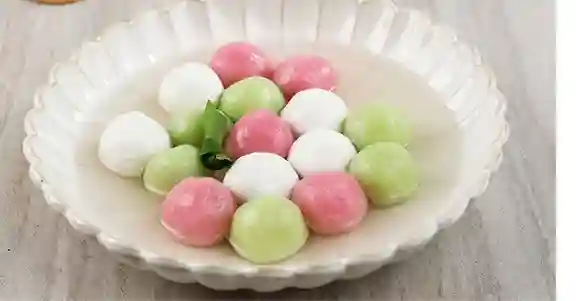
Tang Yuan Sweet Chinese Peanut Rice Balls
Ingredients
- 1 cup roasted peanuts unsalted
- 1/4 cup powdered sugar
- 2 tablespoons vegetable oil or melted butter
- Optional: 1-2 tablespoons honey or condensed milk for added sweetness
Making the Dough
- 2 cups glutinous rice flour
- 1 cup water adjust as needed
- Optional: Food coloring if desired
Instructions
Peanut butter filling
- Spread peanuts in a pan and heat over medium heat on stove. When the pan turns warm, turn to medium low heat. Shake the pan occasionally for even cooking. Toast until the peanuts turn golden but not darkly browned. Alternatively, you can roast the peanuts in 350 F oven for 8 to 15 minutes, or until the surface turns golden. Shake the pan occasionally during baking.
- Ground the peanuts in batches by using a coffee grinder, in a mini food processor, or by using a mortar and pestle until finely grounded, but not into powder. You can leave the pieces a bit larger if you want a chewy texture. Transfer to a bowl. Add peanut butter, sugar and coconut oil. Stir to mix well. Transfer to fridge to harden for about 30 minutes or longer, until it’s possible to scoop out the filling and shape it. If you leave the filling in the fridge for a longer time, it will harden even more and might be a bit difficult to shape. If this is the case, place the filling in room temperature for 5 minutes to let it soften a bit before shaping.
- Use a small spoon to scoop about 1 teaspoon to 1 and 1/2 teaspoon of filling. Shape it quickly into a ball, and place on a small tray or in a container.
- Transfer the peanut butter balls into the freezer while making the dough.
Dough
- Add glutinous rice flour in a big bowl. Slowly add warm water and whisk with a pair of chopsticks (or a spatula). When the water is fully absorbed, use your hands to press and work it into a dough. If the dough is too sticky, add more glutinous rice flour, 1 tablespoon at a time, and keep kneading the dough. Unlike wheat flour dough, rice flour dough does not require a lot of kneading, so it is done once the dough is shaped. Transfer the dough to a big bowl and cover with plastic wrap or a clean wet towel, to prevent it from drying out.
Wrap
- Divide the dough into 4 equal pieces. Shape each piece into a round ball. Work on one dough ball at a time and return the three dough balls back into the large bowl, then cover with plastic wrap.
- Roll the dough ball into a long even strip. Cut to 8 pieces. Roll into small balls.
- Work on the dough balls one by one. Flatten the dough into a round disk that has a dent in the center. Place the filling in the center of the dough. Seal the filling carefully by wrapping and spreading the dough. When you cannot see the filling anymore, roll the dough into a round ball by using both hands.
- If you find the dumpling is too difficult to seal, knead the rest dough balls back together into one big dough ball again, cut into 5 pieces to 6 pieces and try again. It is very important to wrap and seal the dough tightly, so the dumplings won’t fall apart during cooking.
- The filling will become soft if placed in room temperature for too long and become very difficult to wrap, especially if you’re using coconut oil. I suggest you to take out a few filling balls at a time to work with, and store the rest in the freezer.
- Work on the rest of the dough balls using the same method.
- Now you can cook the rice balls or freeze them for later.
Cook
- Bring a pot of water to a boil. Carefully add the number of rice balls you plan to serve. Cook and stir occasionally until the rice balls float on top and the skins look translucent.
- Immediately transfer the rice balls to small serving bowls with just enough boiling water to cover them. We usually eat the rice balls with some boiling water. If it’s not sweet enough for you, add a few drops of honey or osmanthus syrup into the boiling water to sweeten it.
Store
- Place leftover filling in a ziplock bag, squeeze out as much as air as possible, and seal. Store in the fridge for 1 week or in the freezer for up to 3 months.
- To store the raw tang yuan, place them on a tray, 1 finger apart, and cover with a plastic wrap. Freeze until completely frozen. Transfer to a ziplock bag or airtight container, store in the freezer for 2 to 3 months.
- Note, you should always cook the amount of tang yuan you plan to serve and eat them while they’re warm, soon after cooking. Always store the extra tang yuan in the raw form in freezer.
